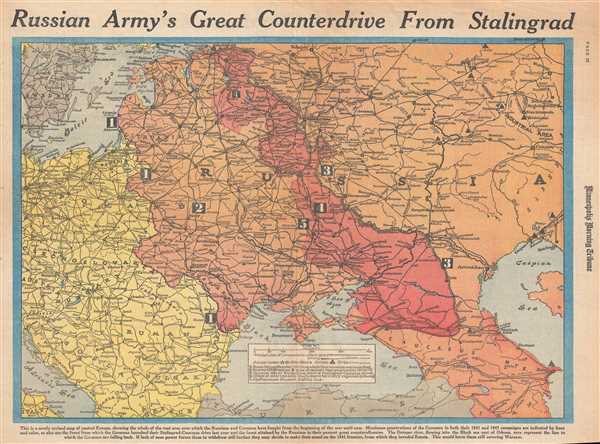This item has been sold, but you can get on the Waitlist to be notified if another example becomes available, or purchase a digital scan.
1943 Wisner Map of Russian Counteroffensive After Victory at Stalingrad
RussianCounterdrive-wisner-1943
Title
1943 (dated) 16 x 22 in (40.64 x 55.88 cm) 1 : 6000000
Description
This map brilliantly presents all of the important information as far as the nuts and bolts of combat on the Eastern Front is concerned, particularly in regards to where all of the major cities are located and how, on a continental scale, the fronts have shifted in general terms. However, this map does not fully disclose the back-and-forth nature of the Eastern Front, or its brutality. Several major cities, including Leningrad and Stalingrad, were besieged by the Germans for incredible amounts of time. Leningrad was under siege for over two years, while the Battle of Stalingrad lasted for five months but has the grim distinction of being the bloodiest battle in human history.
This map was drawn by William H. Wisner and published by the Minneapolis Morning Tribune on Wednesday, March 3, 1943.
CartographerS
William H. Wisner (1894 - December 11, 1963) was the manager of the editorial art department of The Chicago Tribune. Born in Brooklyn, Wisner attended Columbia University and the College of the City of New York. He then attended the Julian academy in Paris where he received his formal art training. He began working for the Tribune in 1913, but left the newspaper during World War I to serve as an attache to the inter-allied mission for propaganda. He rejoined the Tribune in 1919 as head of its editorial art department. Wisner held several posts over the course of his career with the Tribune, including several influential and revolutionary positions concerning the integration of photography into the newspaper. His greatest work, though, was 'when he devoted himself entirely to the complicated task of preparing full-color maps which provided Tribune readers with up-to-the-minute developments on the global battlefronts.' In 1948, Wisner resumed full management of the editorial art department and held that position until his retirement in January 1963. More by this mapmaker...
The Minneapolis Tribune (1867 - present) was founded by Colonel William S. King, William D. Washburn, and Dorilus Morrison and the first issue was published on May 25, 1867. In 1941, the Cowles family of Des Moines, Iowa bought the Tribune and merged it with their other holdings in Minneapolis, giving the Cowles family ownership of all the city's major newspapers. The Tribune became the city's morning newspaper, and the Star-Journal was the evening newspaper. The two published a joint Sunday edition. The newspaper is still published today, under the name Star Tribune. Learn More...

